Holoplankton
On this page...
Stunning images produced by Peter Parks and his team at Oxfordshire based company Image Quest 3-D.
What are Holoplankton?
Holoplankton spend their entire lives as part of the plankton. This group includes krill, copepods, various pelagic (free swimming) sea snails and slugs, salps, jellyfish and a small number of the marine worms. To most people jellyfish are probably the most visible and best known of this group. Australian tropical waters contain a huge diversity of jellyfish, all of which are predatory, securing their prey using stinging cells (nematocysts) or sticky cells (colloblasts). The most famous is the Bluebottle or Portuguese Man-of-War Physalia physalis, which washes up in huge numbers on Australian beaches from time to time.

© Image Quest 3-D
This brilliant Blue Sea Slug is beautifully adapted for life floating upside down in the sea and is often found with the beautiful blue jellyfish Porpita. Blue Sea Slugs feed almost exclusively on the tentacles of Bluebottles, Physalia species. Interestingly, the nematocysts (stinging cells) on these tentacles pass through the Blue Sea Slug intact. The slug can then use these stinging cells in its own defence.

© Image Quest 3-D
Pteropods are tiny, free-swimming marine snails which have developed two wing-like flaps in place of the large muscular foot of most snails. They beat these ‘wings’ constantly to remain near the surface of the ocean.

© Image Quest 3-D
The heteropod is a seafaring snail with a thin fragile shell containing only the heart and gills. It swims upside down, using its tiny shell as a keel. It has a toothy radula (tongue) in its long proboscis and is a voracious hunter, capable of devouring prey as large as itself.

© Image Quest 3-D
Salps belong to the same group as sea squirts: the tunicates or urochordates. Although they may not look it, salps are among the most advanced invertebrates in the sea and are closely related to vertebrates (animals with backbones).

© Image Quest 3-D
Polychaete worms are a group of mostly marine, segmented worms which are related to earthworms and leeches. They are also called bristle worms because of the array of bristles on their many leg-like appendages. Most polychaetes have a planktonic larva which settle on the reef or ocean floor once they have matured but a few species, like the one pictured here, spend their entire lives as part of the plankton.

© Image Quest 3-D
Rhizostome jellyfish have no tentacles. Instead they have clumps of 'oral-arms' with club-like appendages that hang down below. Instead of a single mouth, the oral-arms have many small mouth openings on them. The Jellyfish pumps water and the zooplankton it feeds on through these openings.

© Image Quest 3-D
Arrow worms are a strange group of animals belonging to their very own taxonomic group called Chaetognathids. Also known as ‘Glass worms’ and ‘Tigers of the zooplankton’, they are ambush predators capable of catching large numbers of copepods and swallowing them whole.

© Image Quest 3-D
The Bluebottle or Portuguese Man-of-War is not a single animal but a colony of different polyps (kinds of highly modified individuals). Bluebottles feed using their long stinging tentacles to ensnare small crustaceans and other members of the surface plankton.

